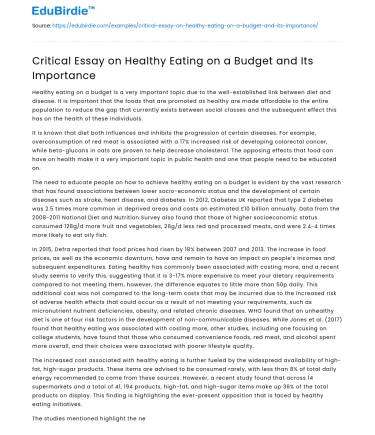Healthy eating on a budget is a very important topic due to the well-established link between diet and disease. It is important that the foods that are promoted as healthy are made affordable to the entire population to reduce the gap that currently exists between social classes and the subsequent effect this has on the health of these individuals.
It is known that diet both influences and inhibits the progression of certain diseases. For example, overconsumption of red meat is associated with a 17% increased risk of developing colorectal cancer, while beta-glucans in oats are proven to help decrease cholesterol. The opposing effects that food can have on health make it a very important topic in public health and one that people need to be educated on.
Save your time!
We can take care of your essay
- Proper editing and formatting
- Free revision, title page, and bibliography
- Flexible prices and money-back guarantee
The need to educate people on how to achieve healthy eating on a budget is evident by the vast research that has found associations between lower socio-economic status and the development of certain diseases such as stroke, heart disease, and diabetes. In 2012, Diabetes UK reported that type 2 diabetes was 2.5 times more common in deprived areas and costs an estimated £10 billion annually. Data from the 2008-2011 National Diet and Nutrition Survey also found that those of higher socioeconomic status consumed 128g/d more fruit and vegetables, 26g/d less red and processed meats, and were 2.4-4 times more likely to eat oily fish.
In 2015, Defra reported that food prices had risen by 18% between 2007 and 2013. The increase in food prices, as well as the economic downturn, have and remain to have an impact on people’s incomes and subsequent expenditures. Eating healthy has commonly been associated with costing more, and a recent study seems to verify this, suggesting that it is 3-17% more expensive to meet your dietary requirements compared to not meeting them, however, the difference equates to little more than 50p daily. This additional cost was not compared to the long-term costs that may be incurred due to the increased risk of adverse health effects that could occur as a result of not meeting your requirements, such as micronutrient nutrient deficiencies, obesity, and related chronic diseases. WHO found that an unhealthy diet is one of four risk factors in the development of non-communicable diseases. While Jones et al. (2017) found that healthy eating was associated with costing more, other studies, including one focusing on college students, have found that those who consumed convenience foods, red meat, and alcohol spent more overall, and their choices were associated with poorer lifestyle quality.
The increased cost associated with healthy eating is further fueled by the widespread availability of high-fat, high-sugar products. These items are advised to be consumed rarely, with less than 8% of total daily energy recommended to come from these sources. However, a recent study found that across 14 supermarkets and a total of 41, 194 products, high-fat, and high-sugar items make up 36% of the total products on display. This finding is highlighting the ever-present opposition that is faced by healthy eating initiatives.
The studies mentioned highlight the need for more public health initiatives focused on healthy eating on a budget, as well as informing people on the best value options and healthy alternatives to high-fat, high-sugar foods. The topic applies to all socio-economic groups, whether they are parents trying to feed a family or a full-time student relying on their student loan – being aware of what you consume is important and so is its cost, whether that’s monetary or the cost to your health.






 Stuck on your essay?
Stuck on your essay?

